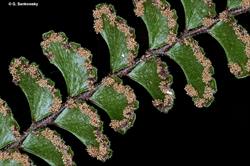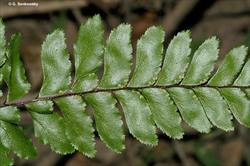Pteridaceae
Australian Tropical Ferns and Lycophytes - Online edition
Adiantum hispidulum





Adiantum hispidulum Sw.
Link to Australian Plant Name Index for publication details and synonyms: https://id.biodiversity.org.au/name/apni/76492
Maidenhair Fern
Rhizome short-creeping, sparsely to richly stoloniferous, c. 3 mm. diam.; scales concolorous, pale or dark brown, with entire margin. Fronds tufted or occasionally scattered along a stolon, 5–70 cm long. Stipe to 45 cm long, dull, together with rachis clothed with antrorse red-brown hairs. Lamina 2–3-pinnate and ±triangular, or helicoid and very broadly ovate to obovate (sometimes with a palmate appearance), 5–30 cm long, 3–25 cm wide, herbaceous to coriaceous. Pinnae narrowly triangular to elliptic. Pinnules at the base of pinnae symmetric and depressed-obovate to flabellate, otherwise dimidiate and rectangular to subtrapeziform; distal margins shallowly lobed, dentate when sterile; surfaces pubescent (rarely glabrous); hairs erect or lax, pale, 1–4-celled. Sori 1–20 per pinnule, along distal margins, 1–4 per lobe; soral flaps oblong or subrectangular, setose, each at the base of a narrow sinus; setae dark brown. Spores to 32 per sporangium, brown, outline in polar view triangular to convex-triangular, perine finely granulate, losely adhering to exine.
Palaeotropics. In Australia it is widespread in all mainland states and territories.
Terrestrial or lithophytic in rainforest, sclerophyll forest, dry vine forest and open woodland. Often along creeks and in rocky areas.
An extremely variable species with four named varieties.
This is a commonly cultivated ornamental fern in tropical, subtropical and temperate areas. It can be grown in a container or in the ground in a shadehouse or semi-shaded part of the garden. Some forms are more drought tolerant and may grow in more exposed situations. It is propagated by spore and by division.
Key to some Adiantum species of tropical
1a. Fronds pinnate = Adiantum philippense
1b. Fronds bipinnate or higher = 2
2a. Pinnules flabellate to rounded = 3
2b. Pinnules obliquely oblong to rhomboid = 5
3a. Soral flaps broadly attached to lamina and situated on the ends of lobes with incisions between them = Adiantum capillus-veneris
3b. Soral flaps reniform and narrowly attached to lamina and situated in incisions of the lamina margin with lobes between them = 4
4a. Rhizome long creeping, rhizome scales translucent with entire margins, plants stoloniferous and spreading, pinnae pale bright green when mature = Adiantum aethiopicum
4b. Rhizome short creeping, rhizome scales opaque with denitculate margins, not stoloniferous plants tufted, pinnae dark green when mature = Adiantum atroviride
5a. Rhizome long creeping, fronds scattered = 6
5b. Rhizome not long creeping, fronds tufted = 7
6a. Primary pinnae progressively reducing in length from base to apex of frond resulting in a triangular lamina = Adiantum formosum
6b. Primary pinnae equal in length resulting in an ovate lamina = Adiantum silvaticum
7a. Pinnae soft and membraneous with fine black hairs on the undersurface, root tubers present, often proliferous, stipe smooth = Adiantum diaphanum
7b. Pinnae herbaceous to coreaceous with white hairs, root tubers absent, not proliferous, stipe not smooth = Adiantum hispidulum
Field AR, Quinn CJ, Zich FA (2022) Australian Tropical Ferns and Lycophytes. apps.lucidcentral.org/fern/text/intro/index.htm (accessed online INSERT DATE).
Field AR, Quinn CJ, Zich FA (2022) ‘Platycerium superbum’, in Australian Tropical Ferns and Lycophytes. apps.lucidcentral.org/fern/text/entities/platycerium_superbum.htm (accessed online INSERT DATE).







